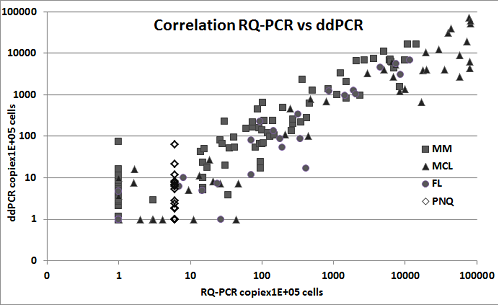Konference: 2014 19th Congress of the European Hematology Association - účast ČR
Kategorie: Maligní lymfomy a leukémie
Téma: Non-Hodgkin & Hodgkin lymphoma - Biology (Poster)
Číslo abstraktu: P1064
Autoři: Daniela Drandi; Mgr. Lenka Bešše (Kubiczková); Simone Ferrero; Nadia Dani; Roberto Passera; Barbara Mantoan; Manuela Gambella; Elona Saraci; MD Marco Montillo; Elisa Genuardi; Daniela Barbero; Paola Ghione; Guglielmo Guarona; Paola Omede; Davide Barberio; prof. MUDr. Roman Hájek, CSc.; Prof. Umberto Vitolo; M.D. Sergio Cortelazzo; MD Antonio P. Palumbo; MD Mario Boccadoro; Giorgio Inghirami; Dr. Marco Ladetto
ABSSUB-3411
Background: Minimal residual disease (MRD) detection is a well described prognostic tool for response evaluation in several hematological malignancies. Real time quantitative PCR (RQ-PCR) has an established role in Mantle cell Lymphoma (MCL), Follicular Lymphoma (FL) and Multiple Myeloma (MM). However, RQ-PCR-based MRD detection is a relative quantification approach, since it requires a reference standard curve. Droplet Digital PCR (ddPCR), based on wide sample partition and Poisson’s statistic, allows for a trustworthy absolute quantification.
Aims: This study compares RQ-PCR and ddPCR in the context of IgH and Bcl-2/MBR targets detection for MRD analysis, to assess whether ddPCR could be useful in MRD setting, overcoming some RQ-PCR limits and providing at least similar performances without losing its critical advantages.
Methods: Genomic DNA (gDNA) from 18 MM, 20 MCL and 30 FL patients enrolled in clinical trials and selected for having the IgH (MM and MCL) or Bcl-2/MBR (FL) molecular marker, were employed. Overall 224 samples (179 BM and 45 PB) were analyzed: 95 MM, 69 MCL and 60 FL of whom 70 were taken at diagnosis and 154 after treatment. MRD detection was carried out by RQ-PCR as previously described, [Ladetto M et al. BBMT 2000, Ladetto M et al. Exp Hem 2001] and results were interpreted according to the Euro-MRD guidelines [van der Velden VHJ et al. Leukemia 2007]. ddPCR was performed by the QX100 droplet system (Bio-Rad Inc) on 500ng of gDNA combined with the same Allele Specific Oligonucleotides (ASO) or Bcl-2/MBR primers and TaqMan-probes used in the RQ-PCR. Results were expressed as amount of target copies per 1E+05 cells. ddPCR and RQ-PCR comparability was assessed by means of bivariate correlations between methods analysis (R2.15.1 package irr). Discordances were classified as follows: a positive/negative qualitative discordance was defined as major when the positive result was >1E-04 and minor when ≤1E-04; a quantitative discordance was defined as the presence of two positive results with a quantitative discrepancy >1 log.
Results: MRD analysis was successful in 97% of patients by RQ-PCR (no reliable standard curve was achieved in 2 MCL patients) and 100% by ddPCR. Overall 222/224 samples (99.1%) were evaluated by both methods and a highly significant level of concordance was observed (R2=0.88) (Fig). MRD detection was fully concordant in 189/222 samples (Cohen’s K=0.85) with 137/222 (61.7%) concordantly positive and 52/222 (23.4%) concordantly negative samples. 33/222 (14.9%) were defined as discordant. Only 4/222 (1.8%) samples showed a major qualitative discordance (2MM, 1MCL, 1FL), while 29/222 (13%) were minor qualitative discordances (16MM, 11MCL, 2FL), which most likely reflect Poisson’s statistics variation related to the very low number of target copies. 6/222 (2.7%) quantitative discordances were observed (1MM, 4MCL, 1FL). Among qualitative discordances no systematic prevalence of positive cases was observed with either tools (8.6% positive or higher by RQ-PCR, 7.6% positive or higher by ddPCR). Of note, 26/222 samples (11.7%) resulted positive not quantifiable by RQ-PCR. In four of them ddPCR was able to provide a reproducible quantitative result.

Summary/Conclusion: This is the first head to head comparison between ddPCR and RQ-PCR in the context of MRD evaluation in lymphoproliferative disorders. We showed that ddPCR is a feasible tool for MRD monitoring in MM, MCL and FL, with similar sensitivity and excellent quantification ability, even at very low MRD levels. Moreover, due to its absolute quantification skill, ddPCR provided considerable technical simplification, bypassing the need of rely on a standard curve, reducing costs and sparing of valuable diagnostic tissue. These features make ddPCR a feasible and attractive alternative method to RQ-PCR for MRD assessment, potentially worthwhile of being considered for multi-lab standardization.
Keywords: Lymphoproliferative disorder, Minimal residual disease (MRD), PCR, Quantitative molecular analysis
Datum přednesení příspěvku: 13. 6. 2014





